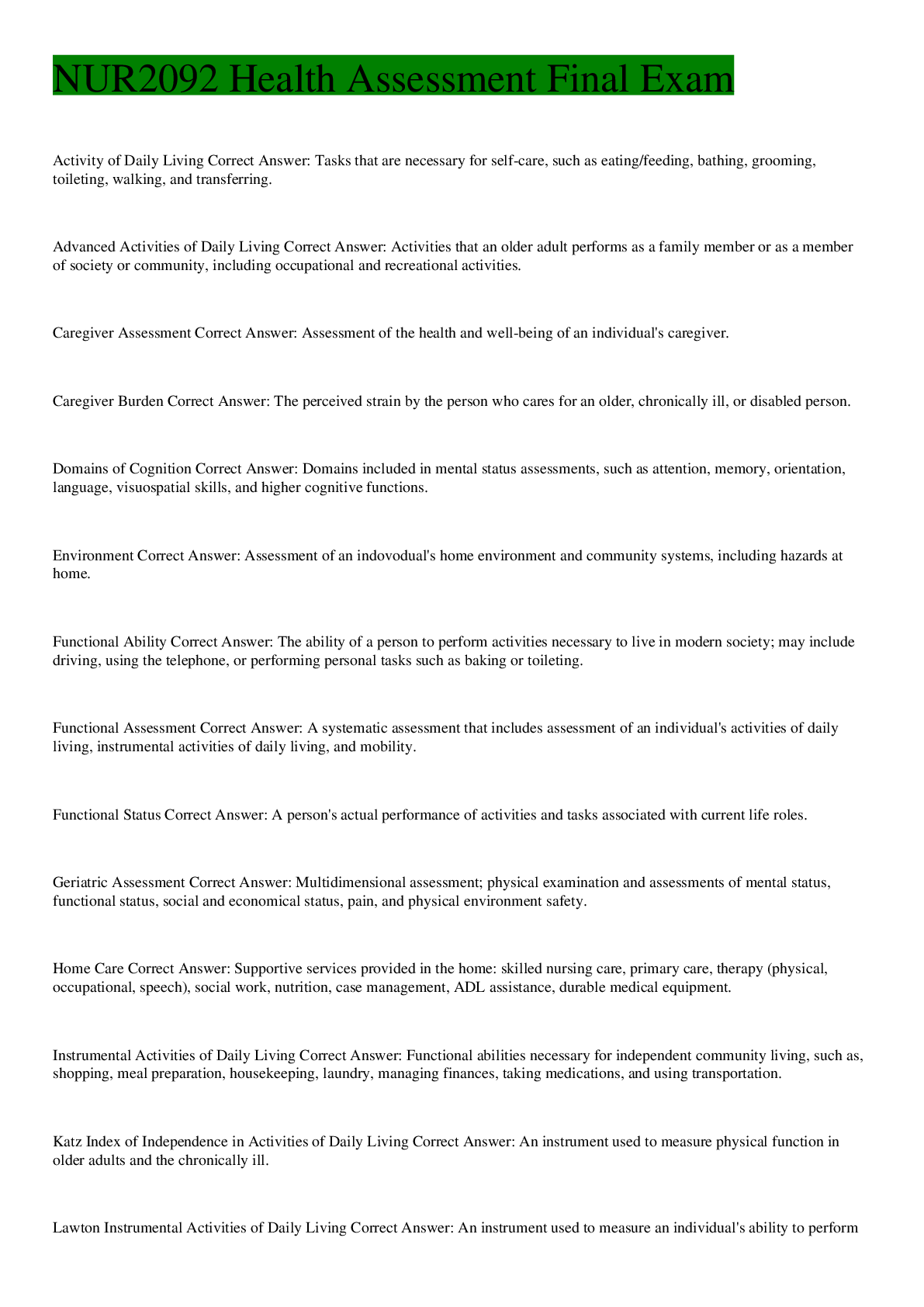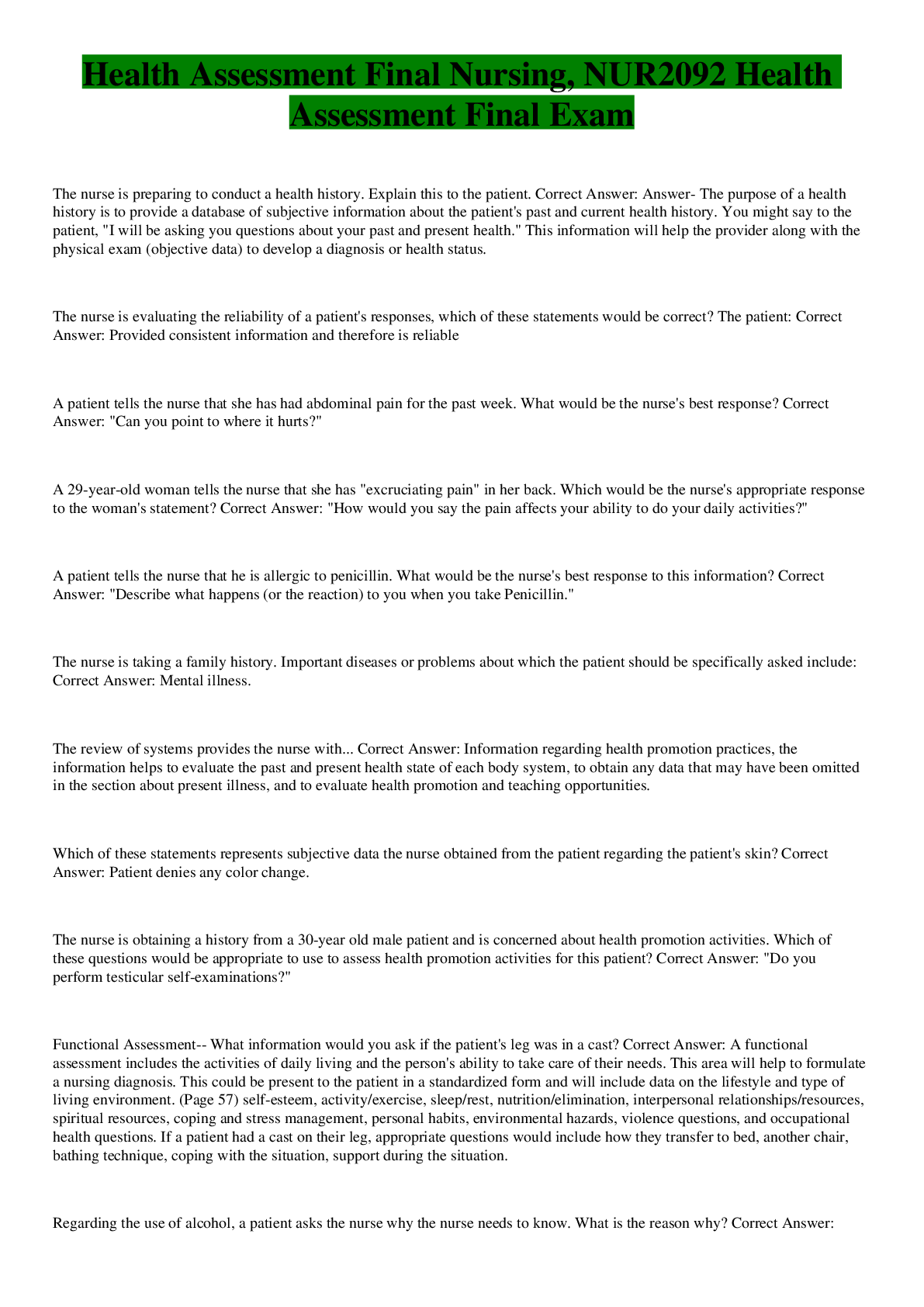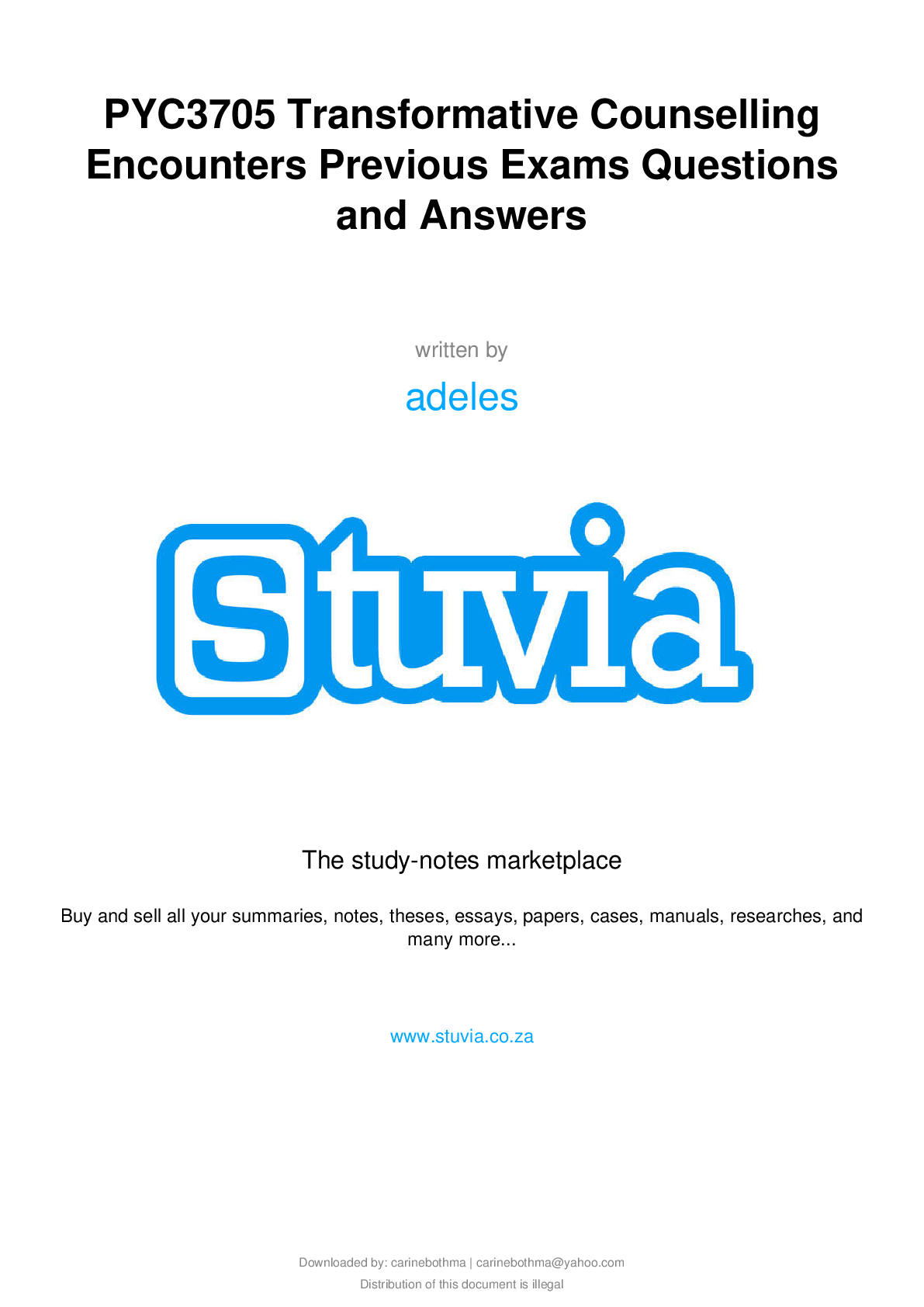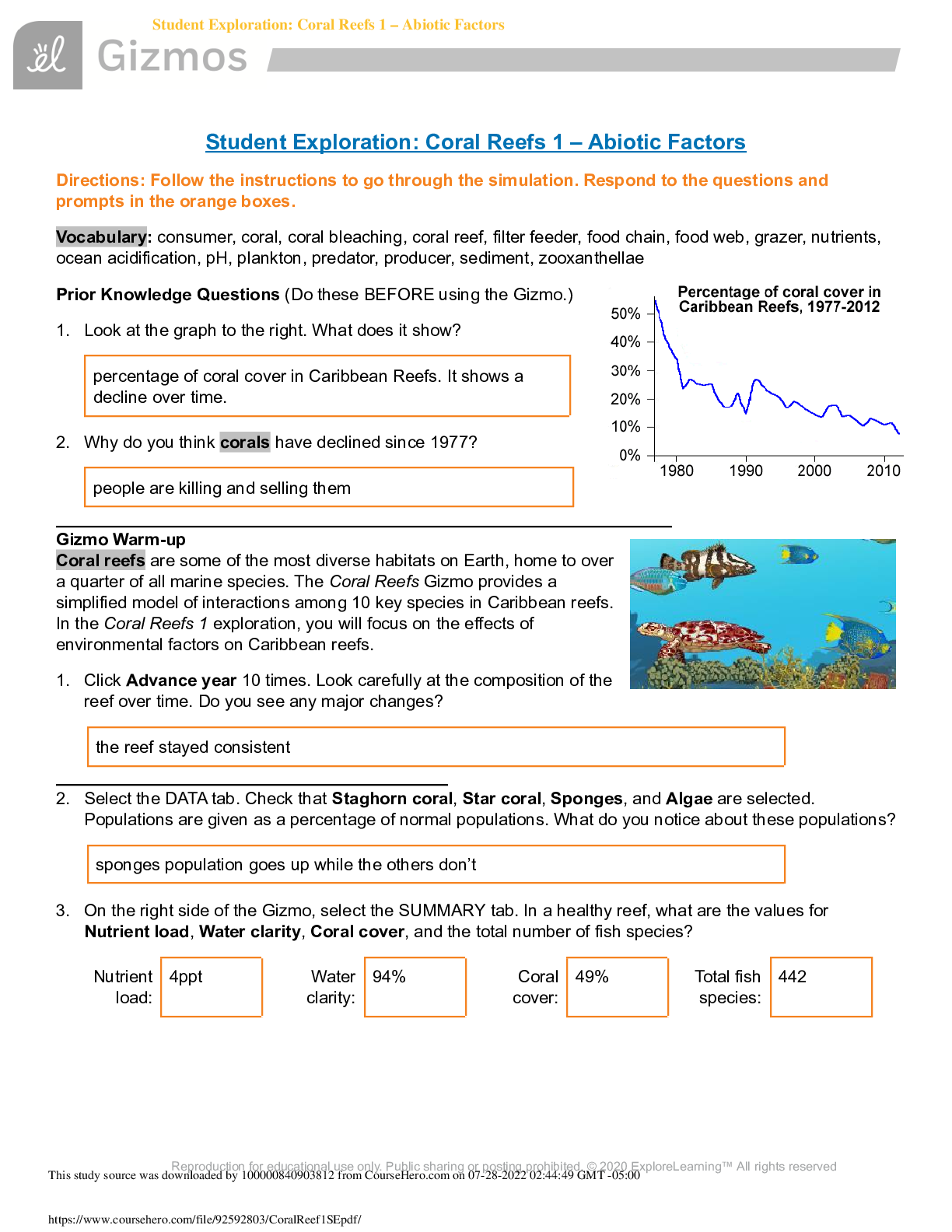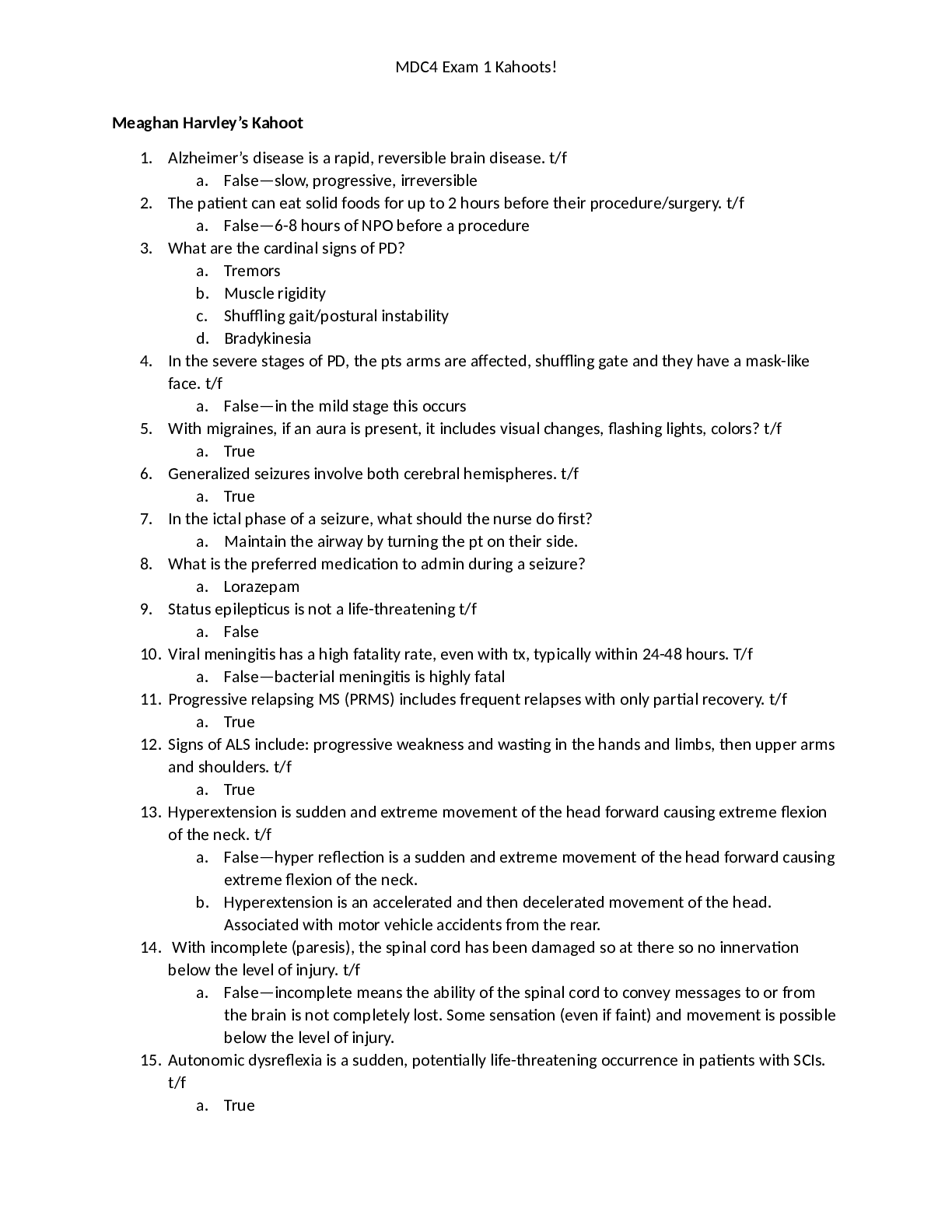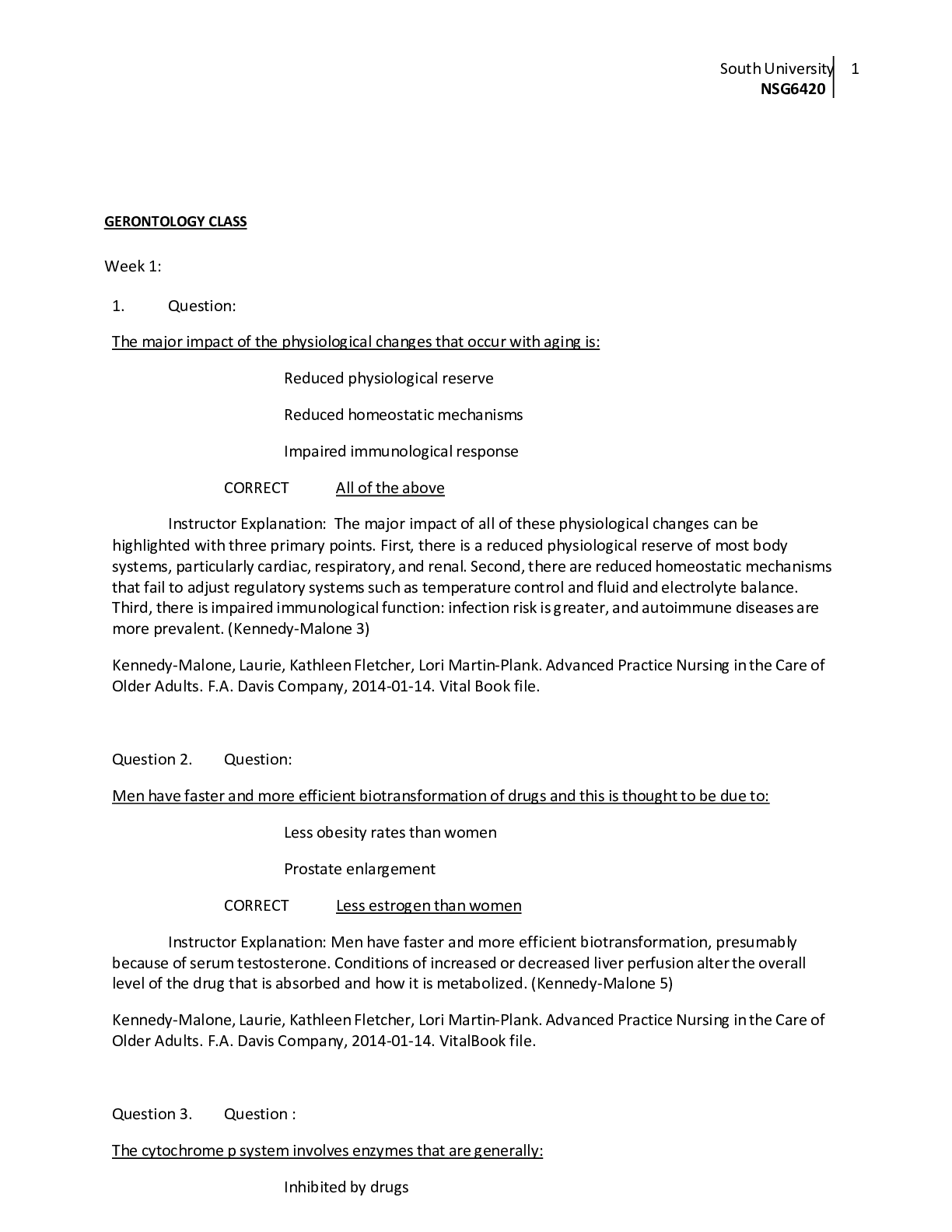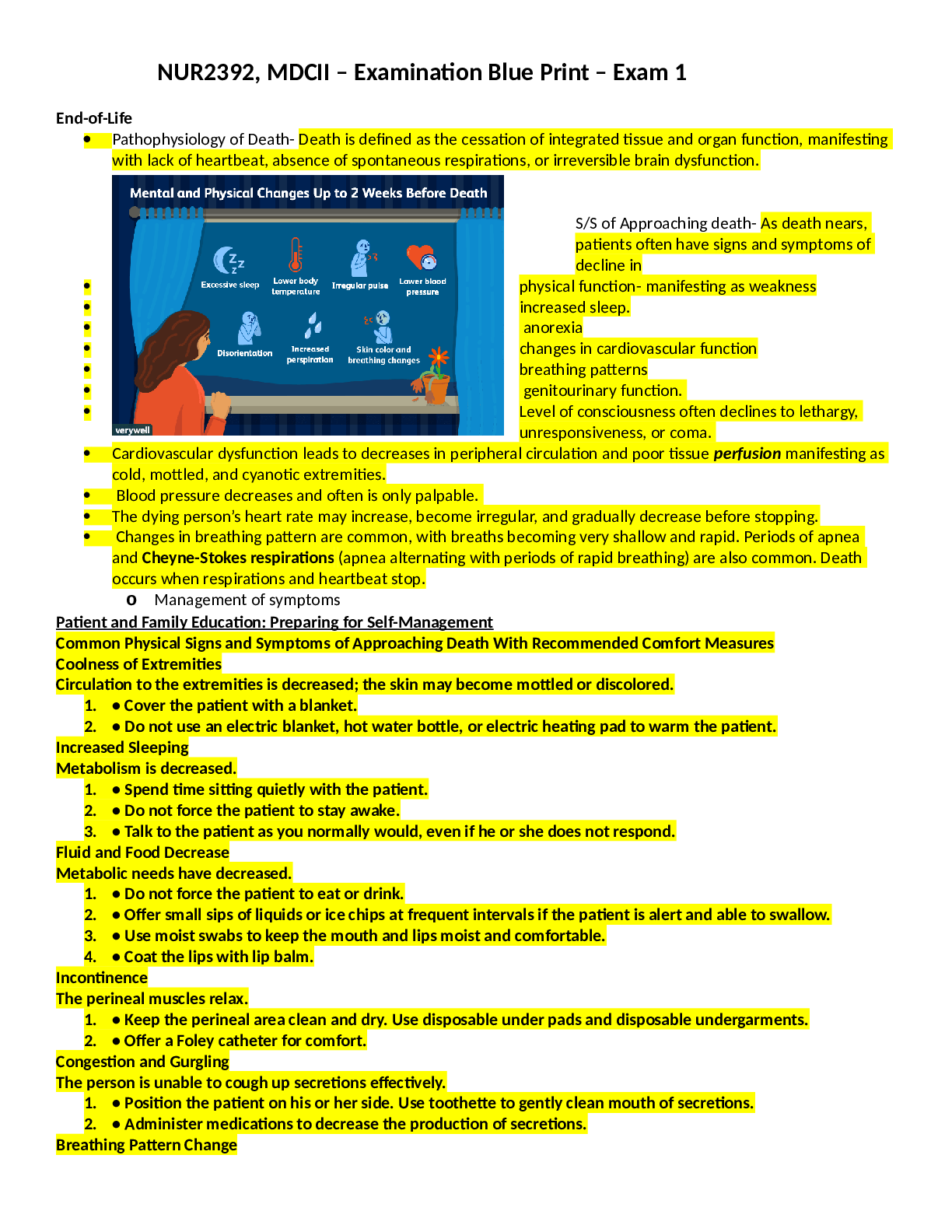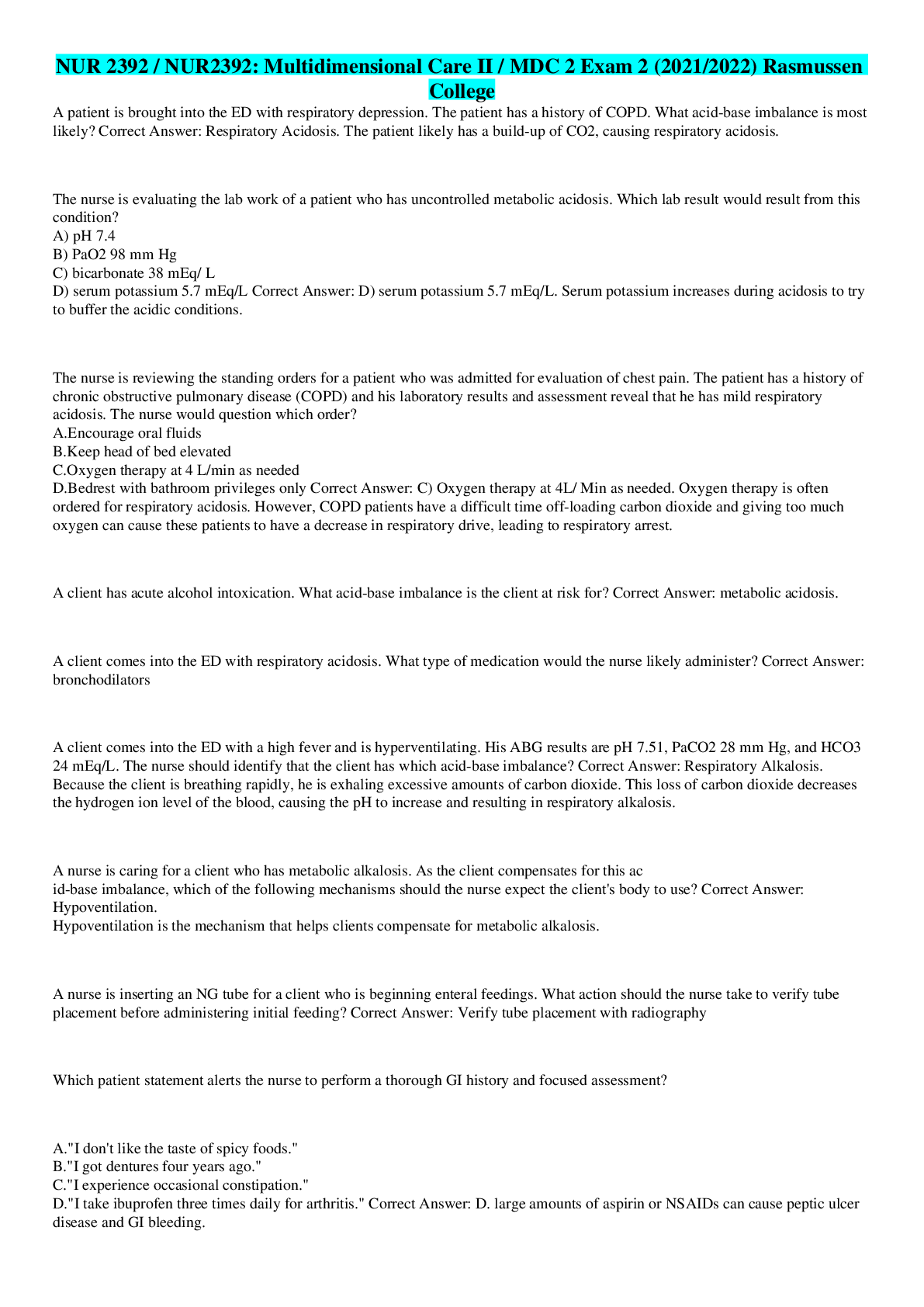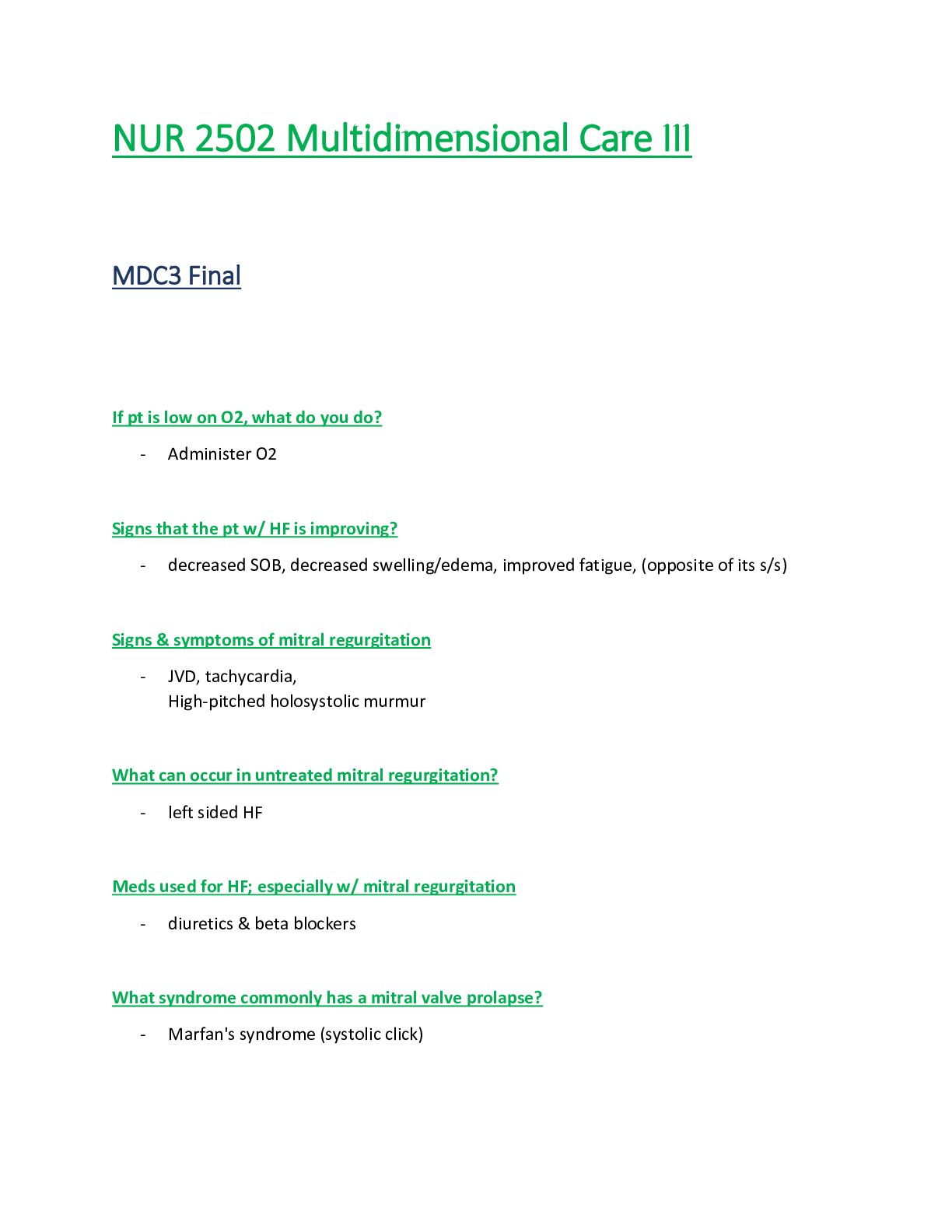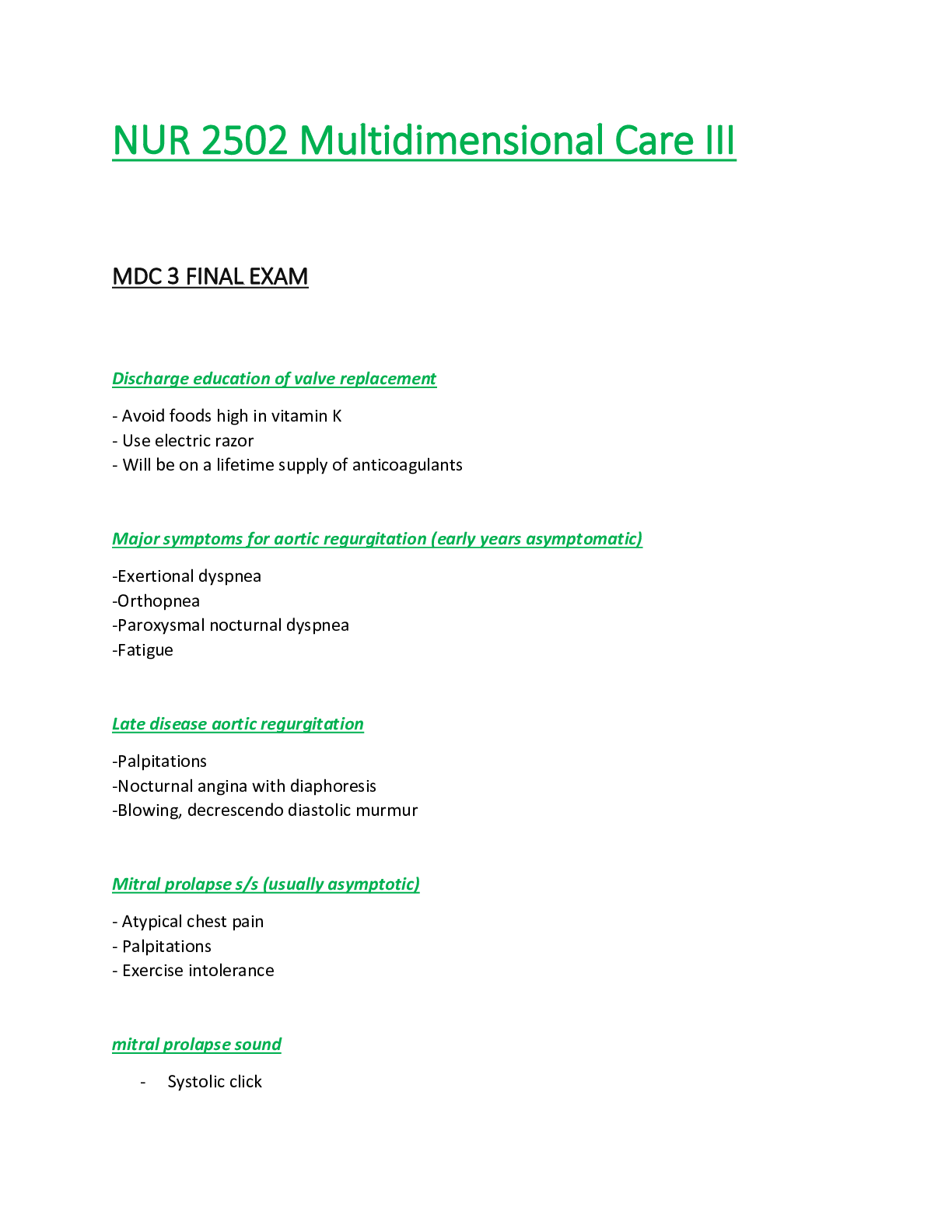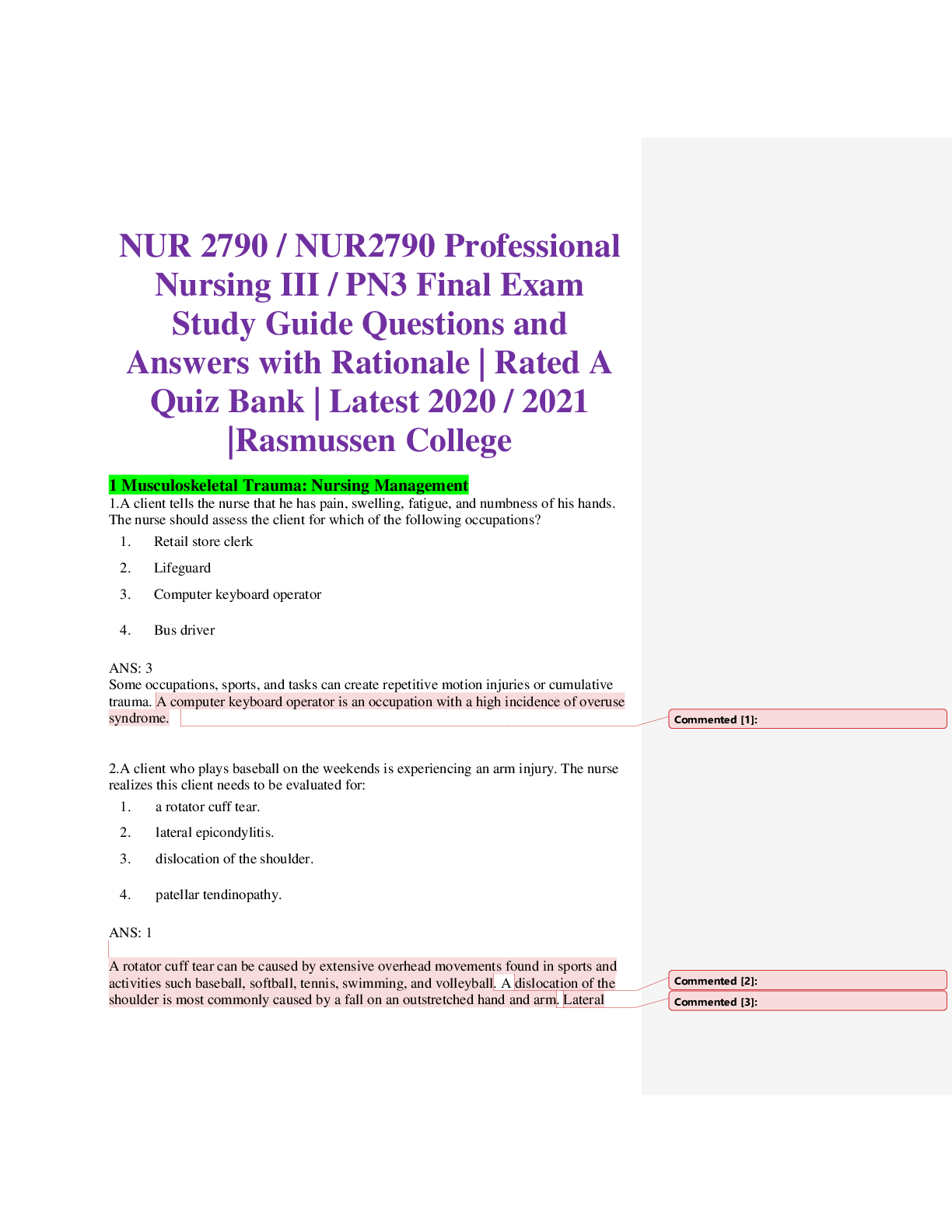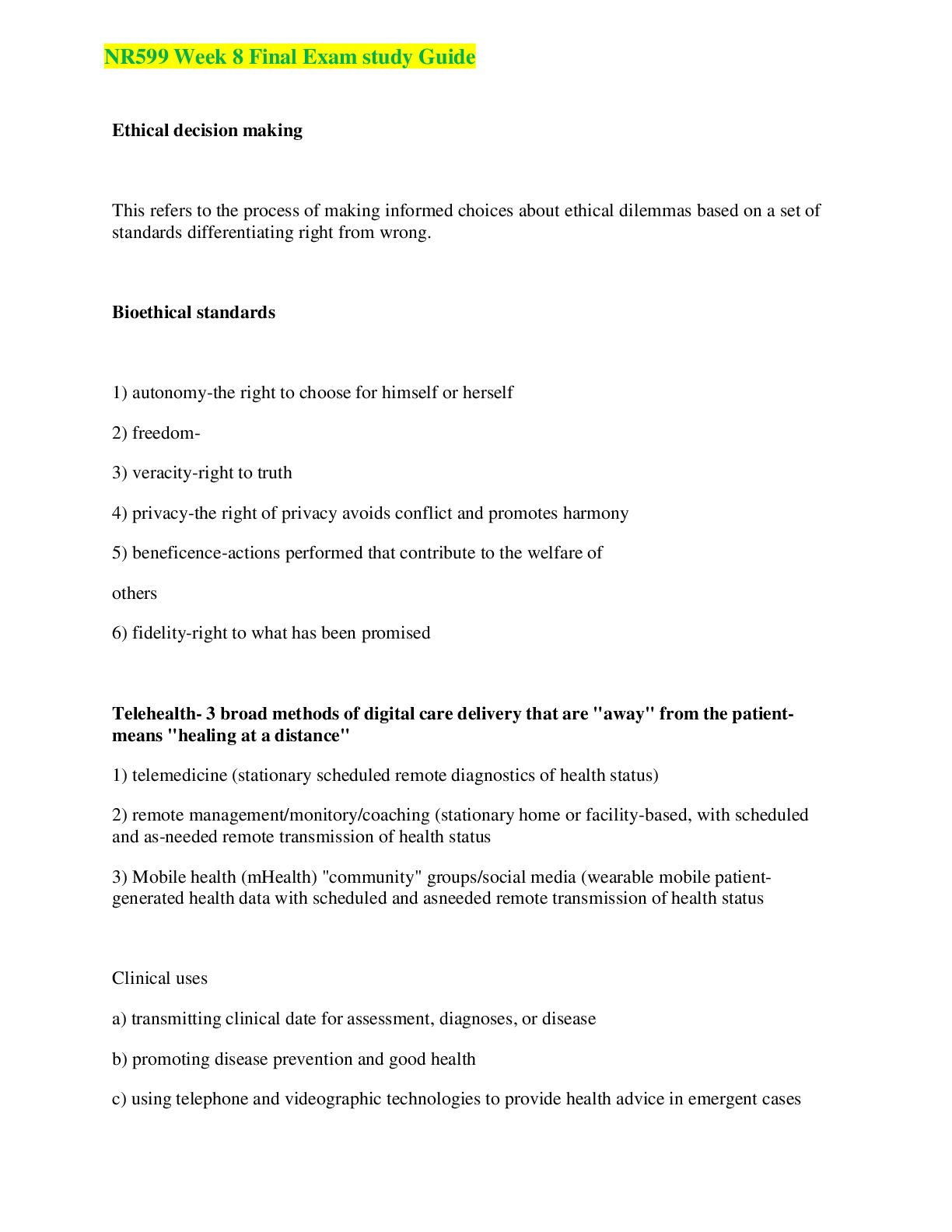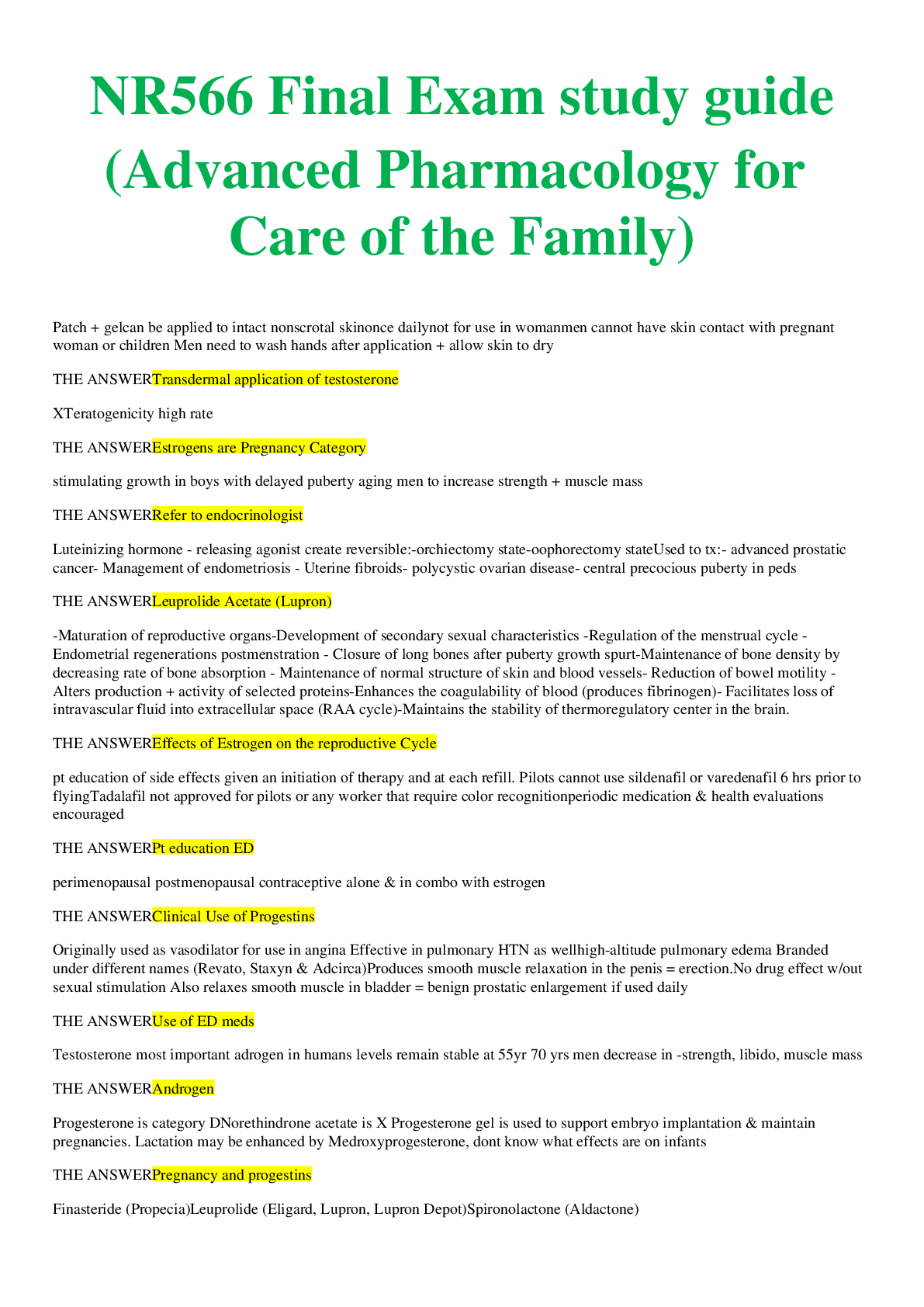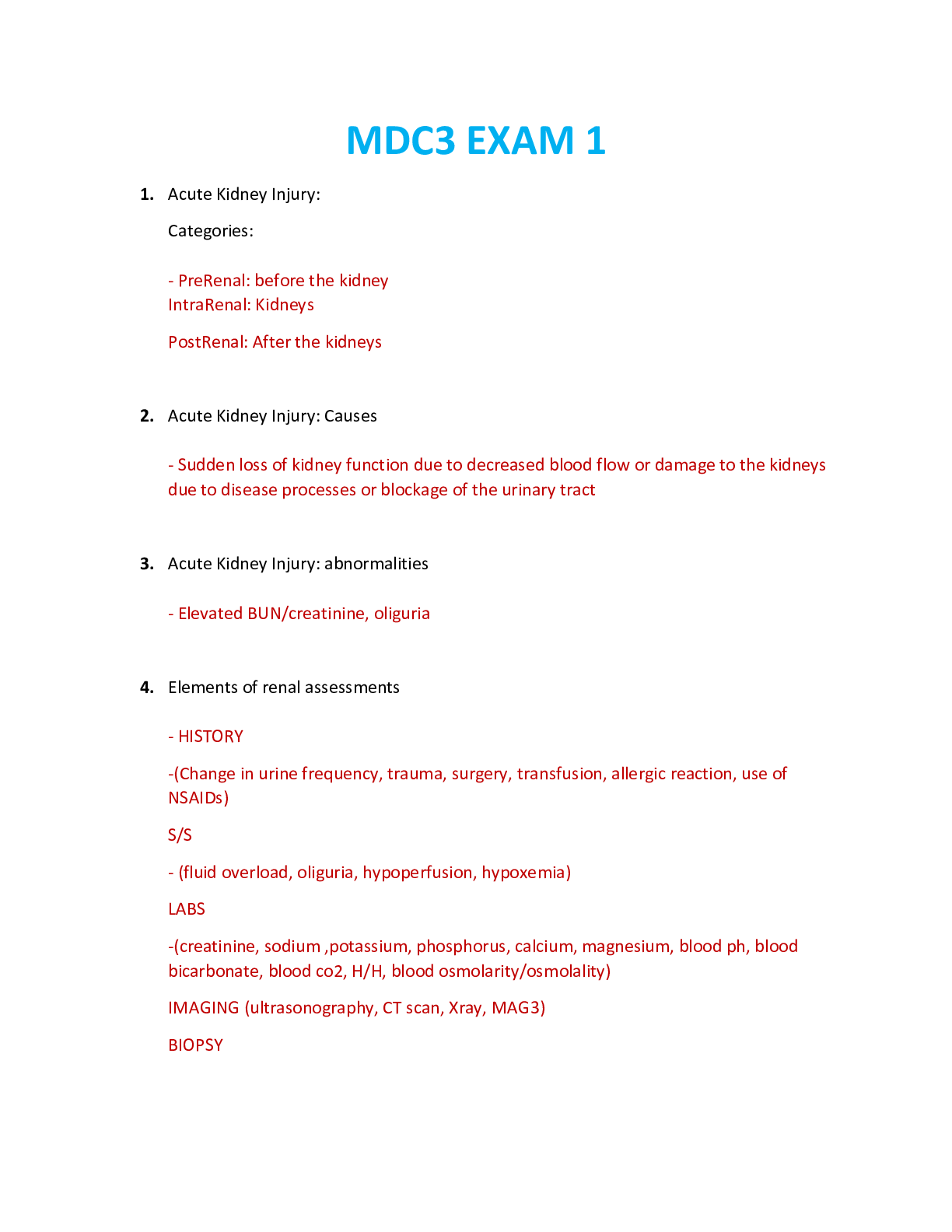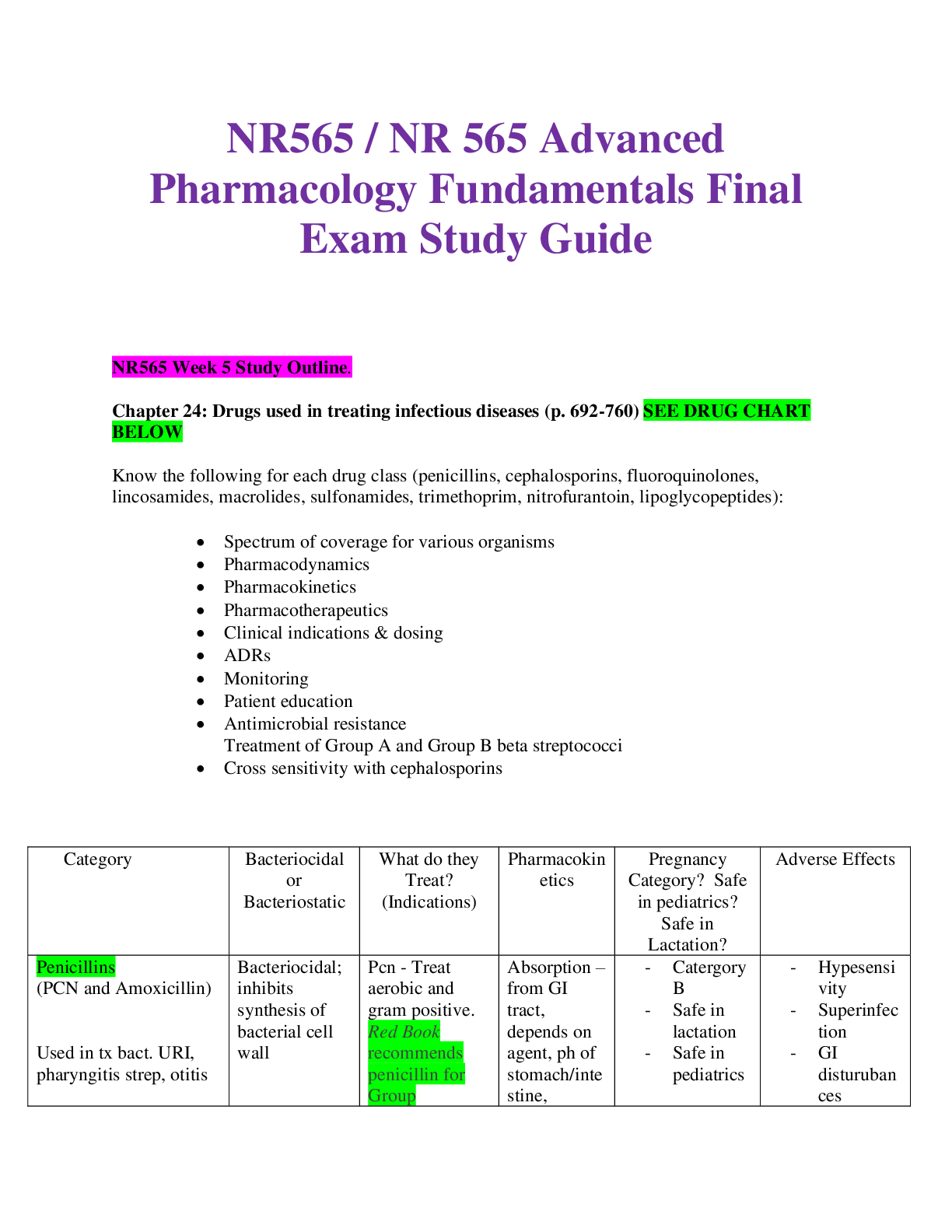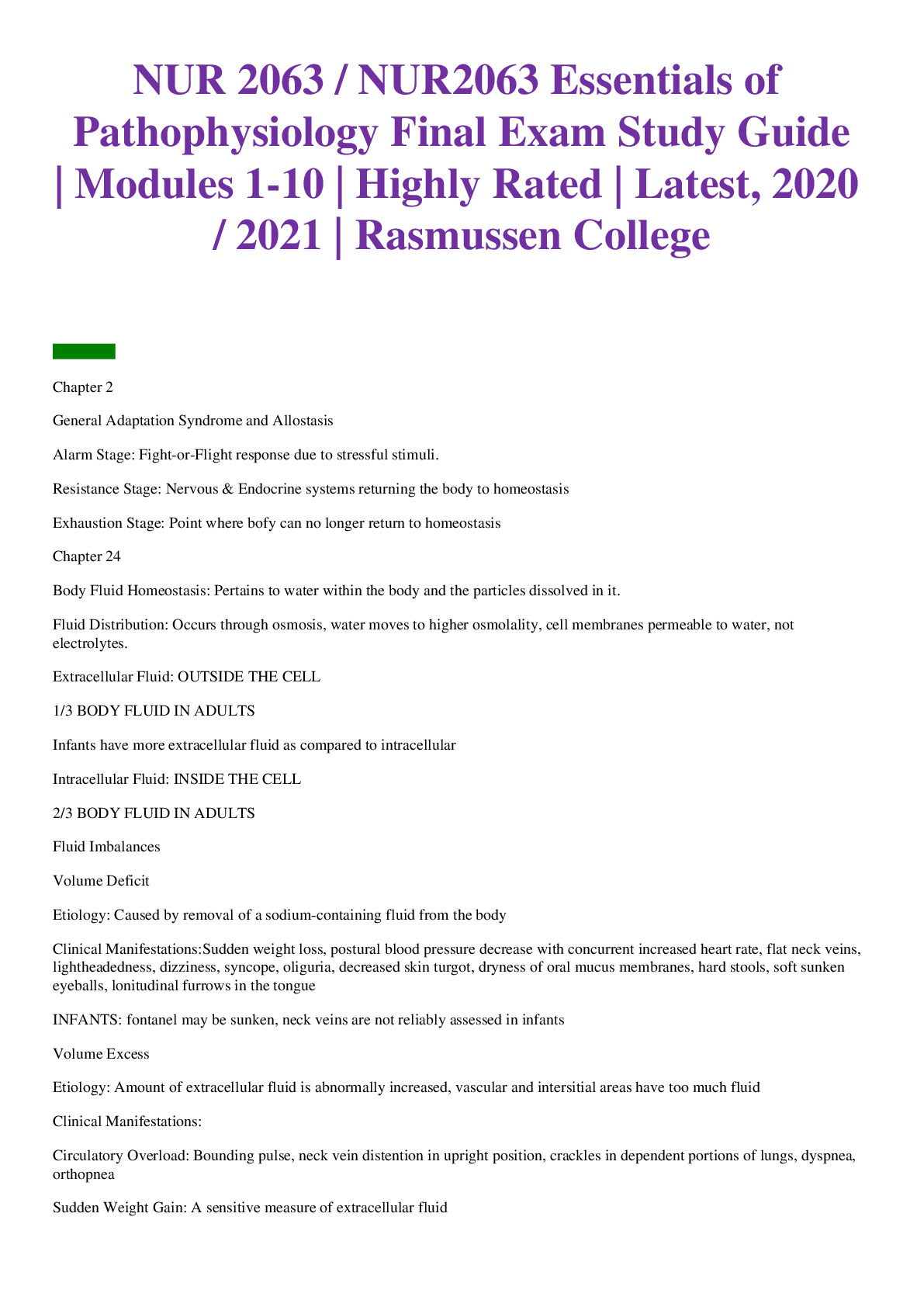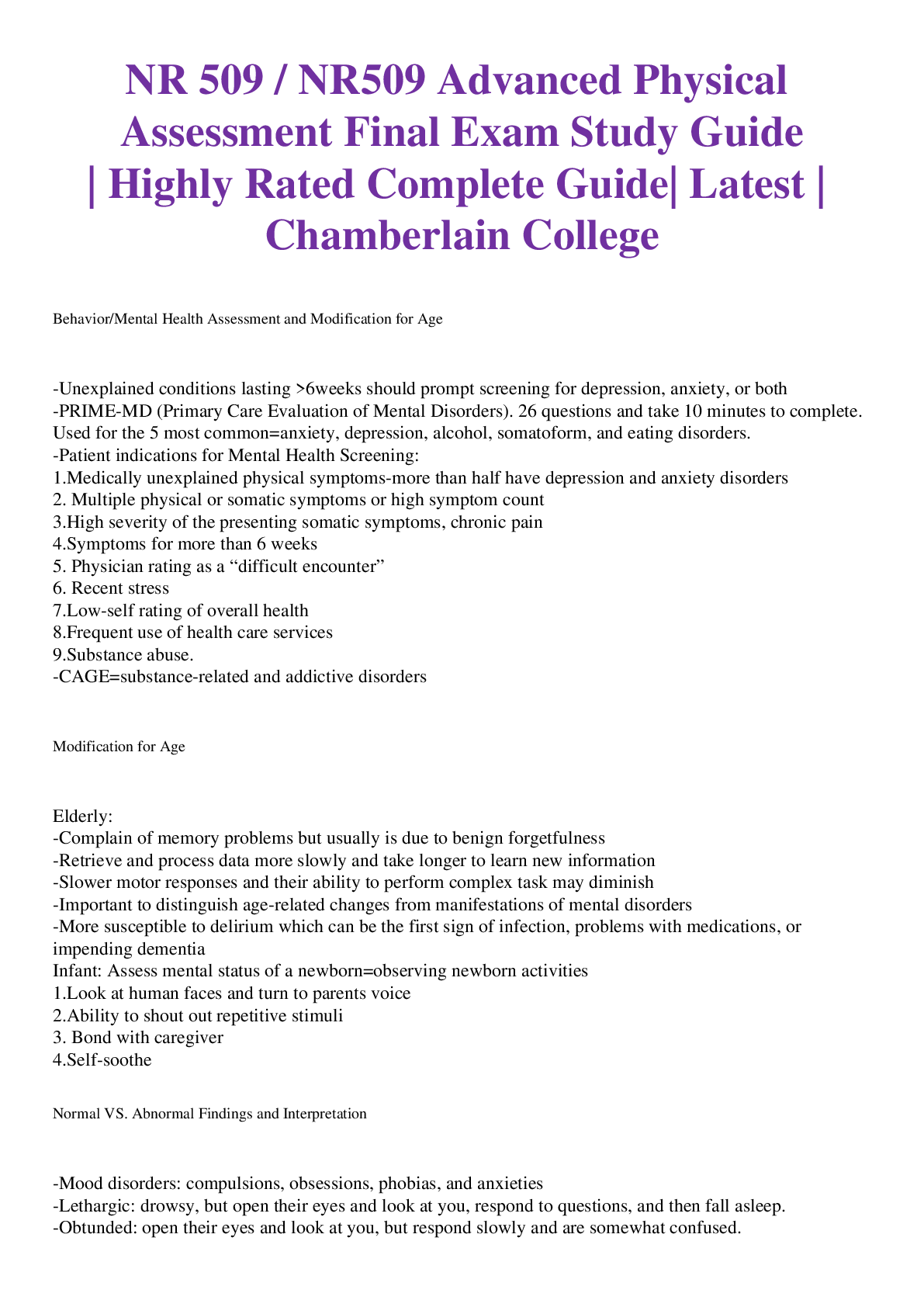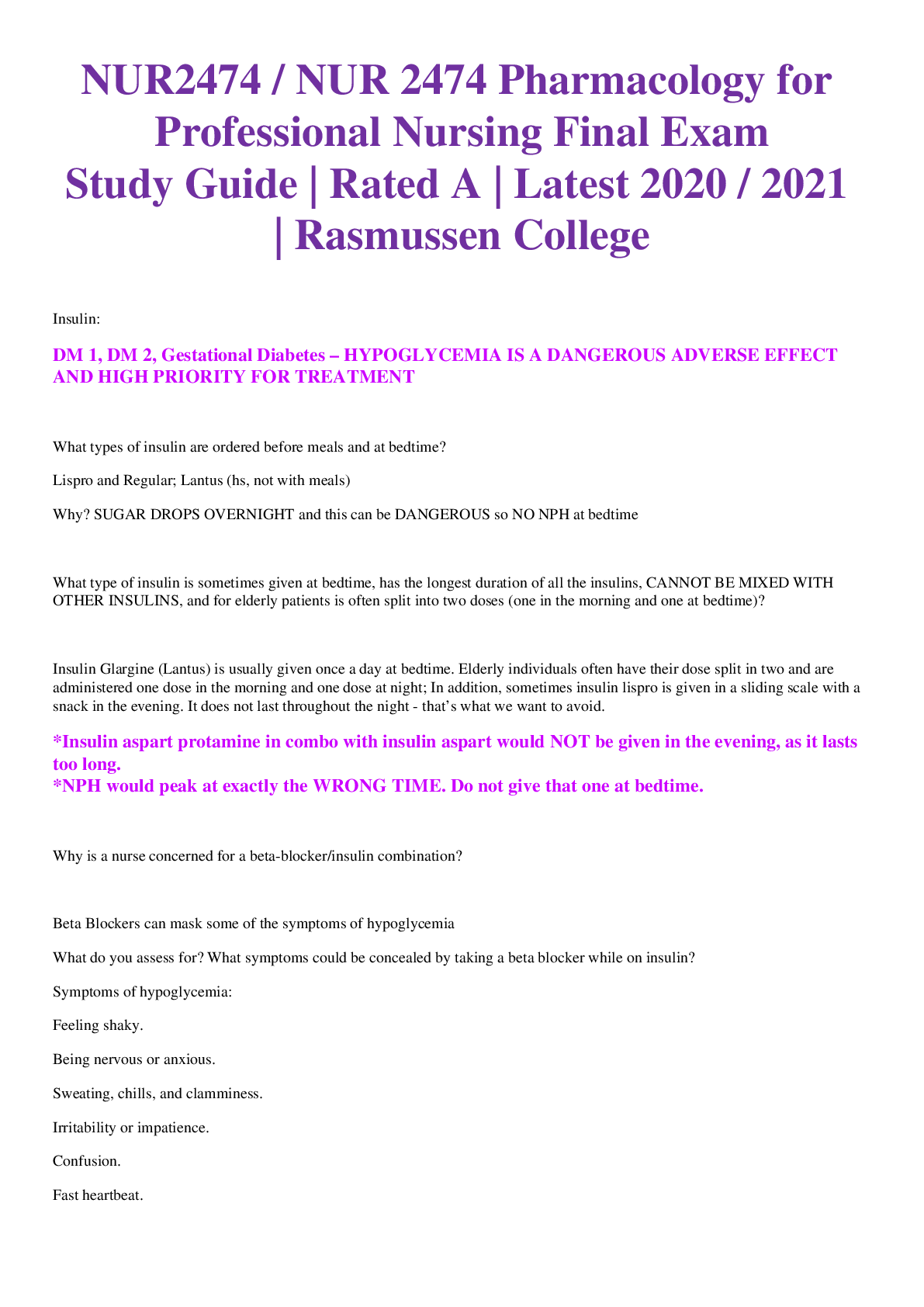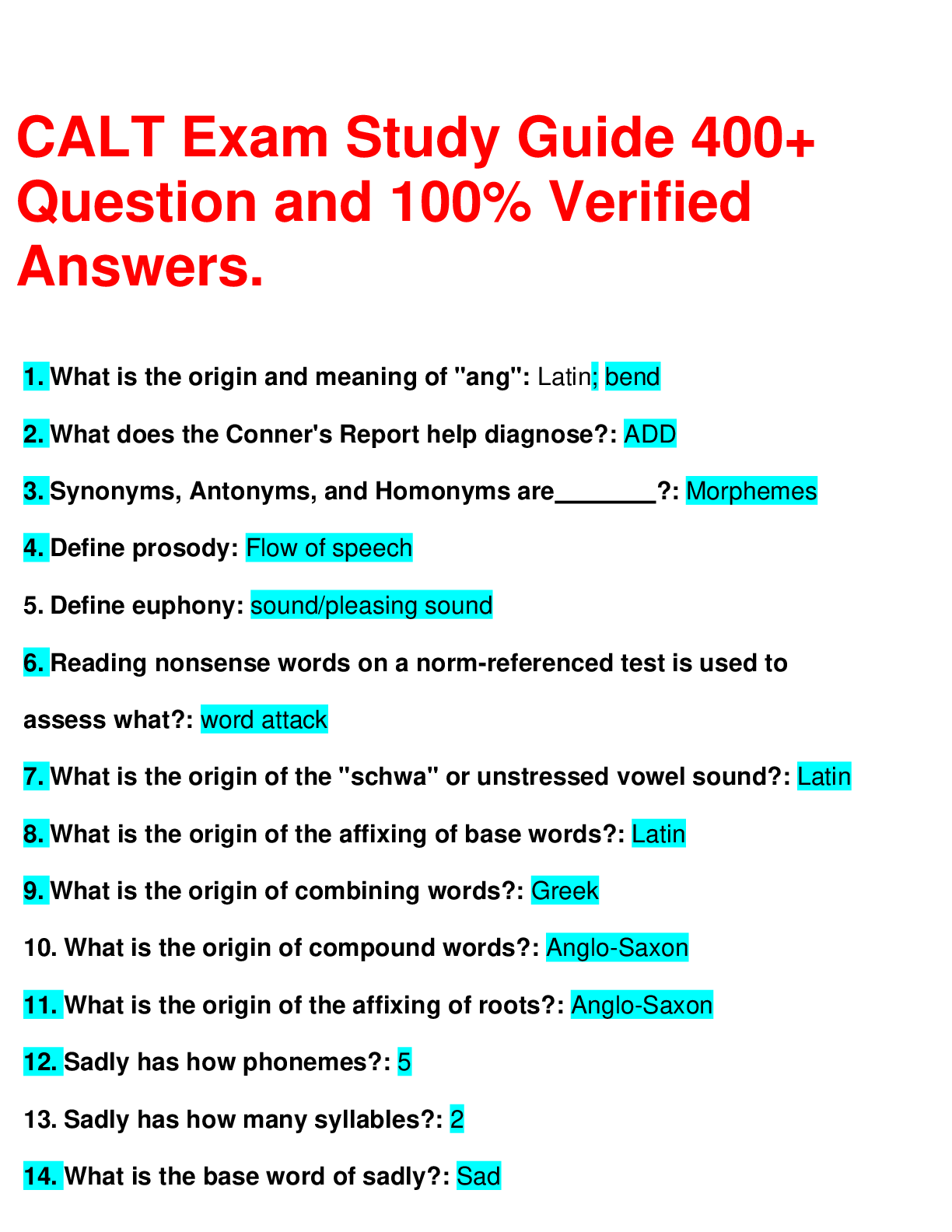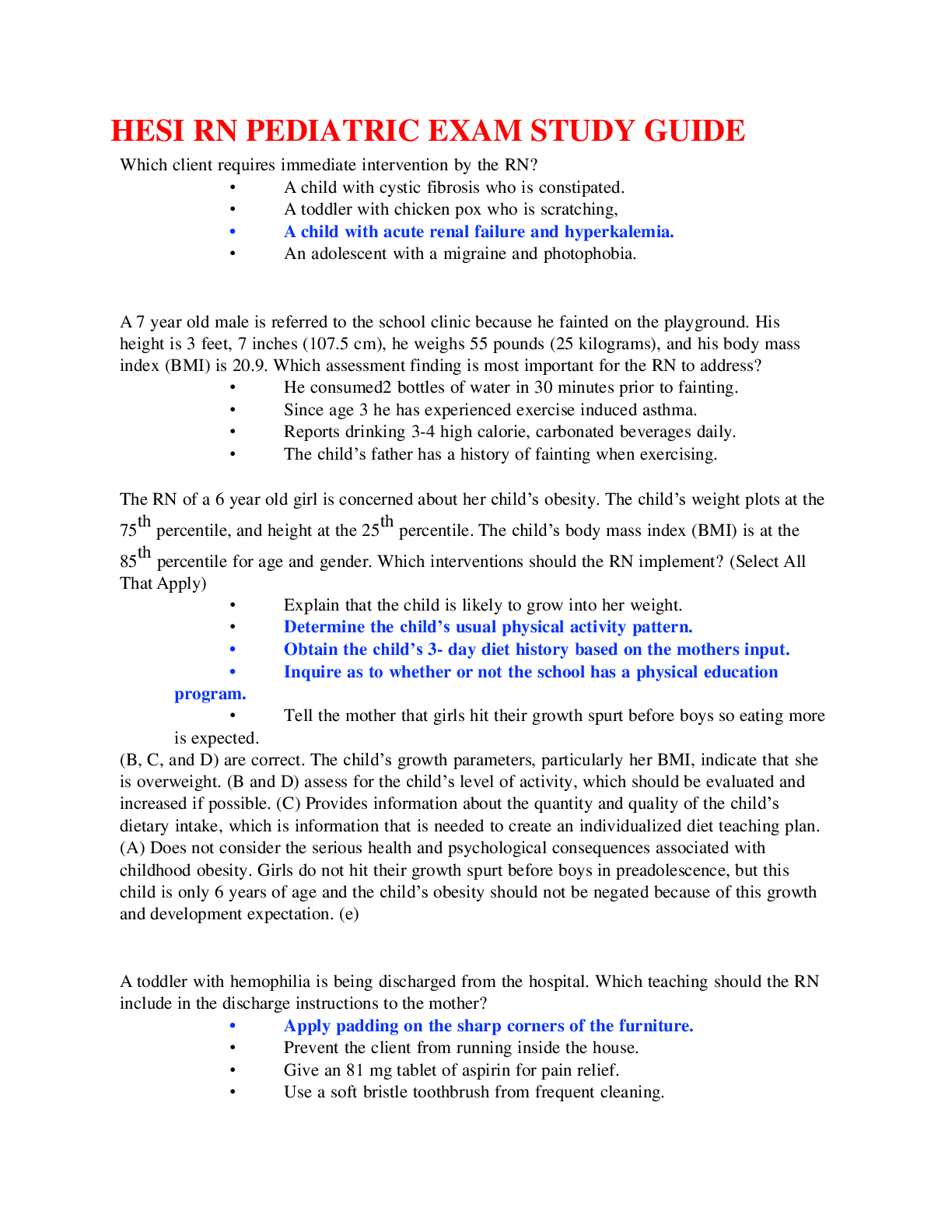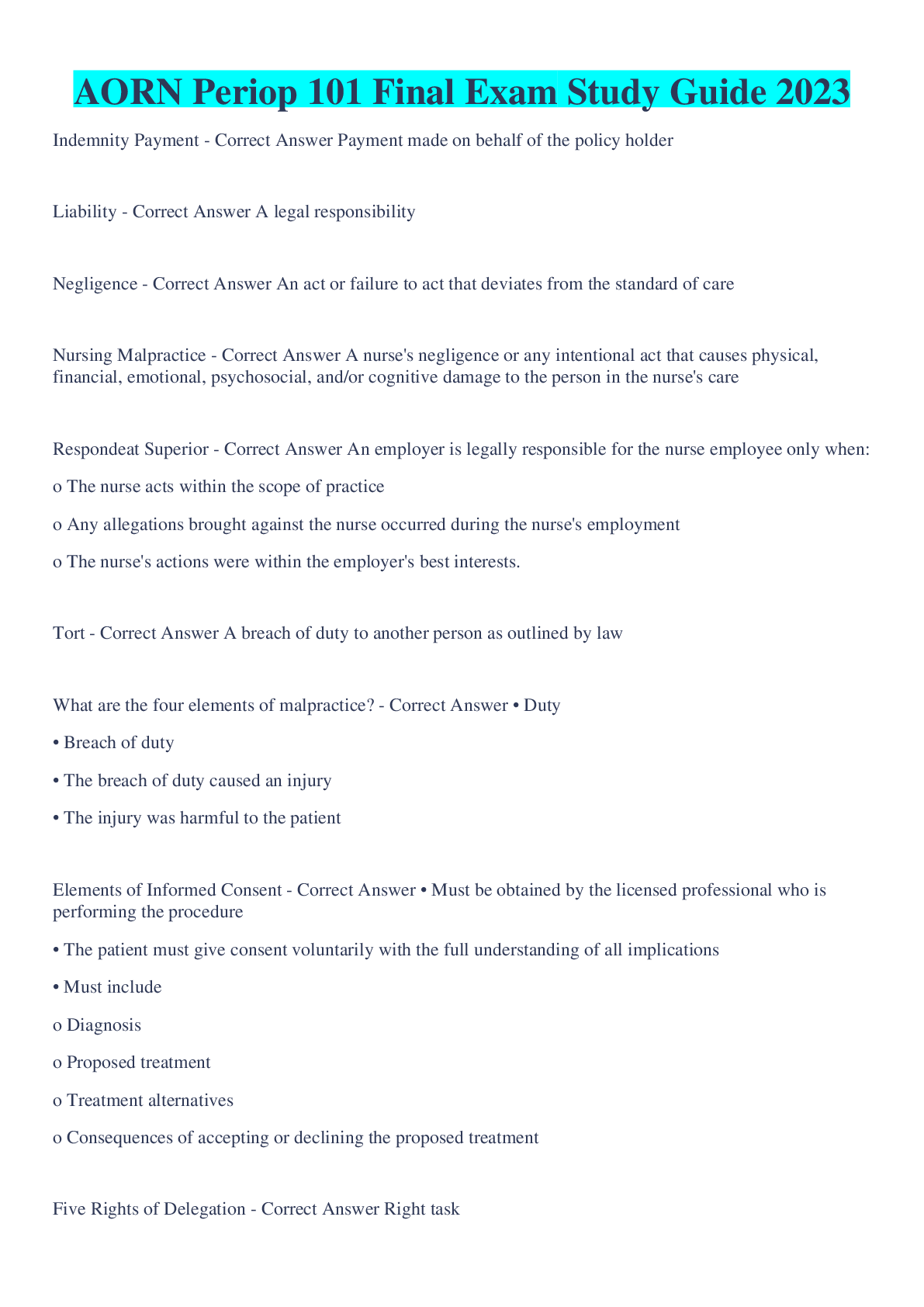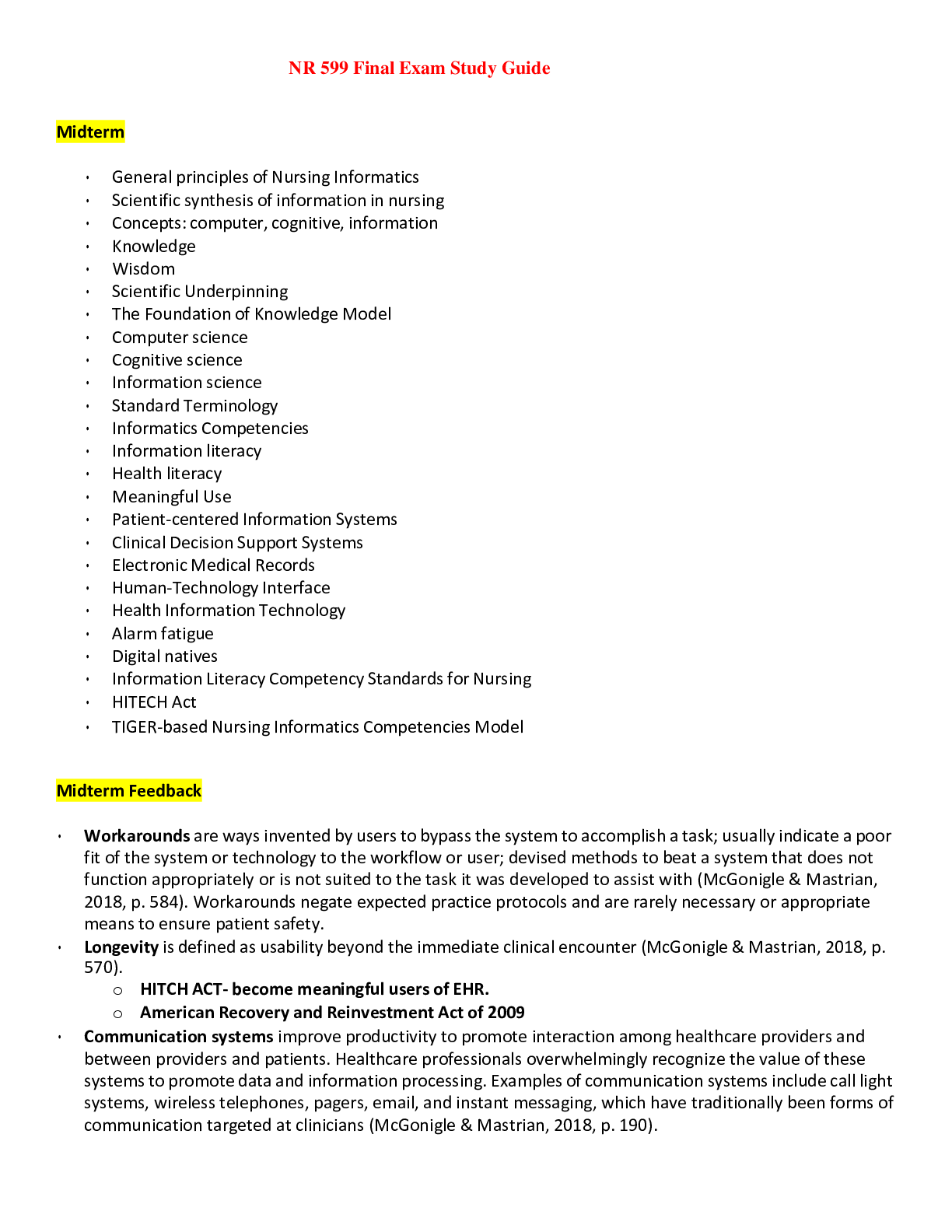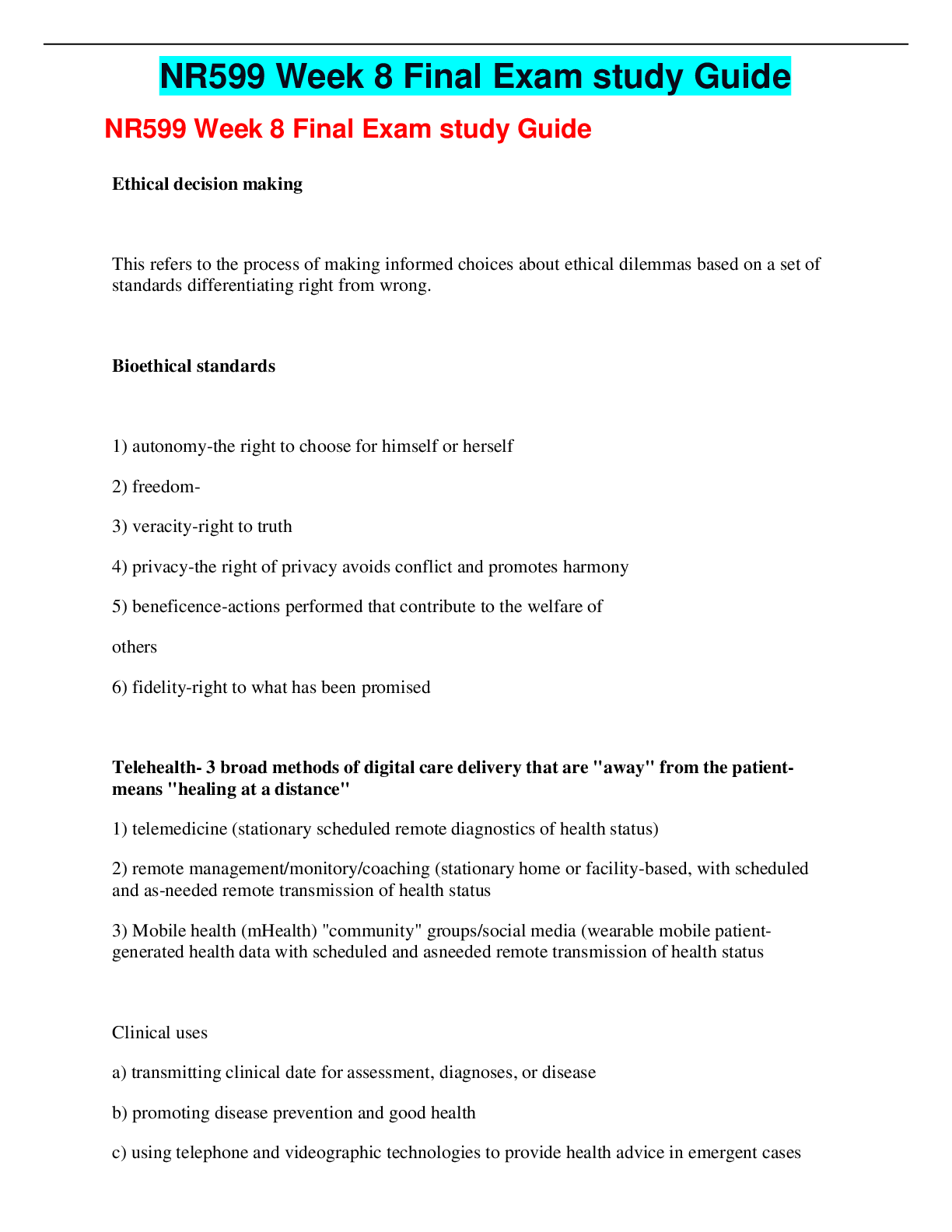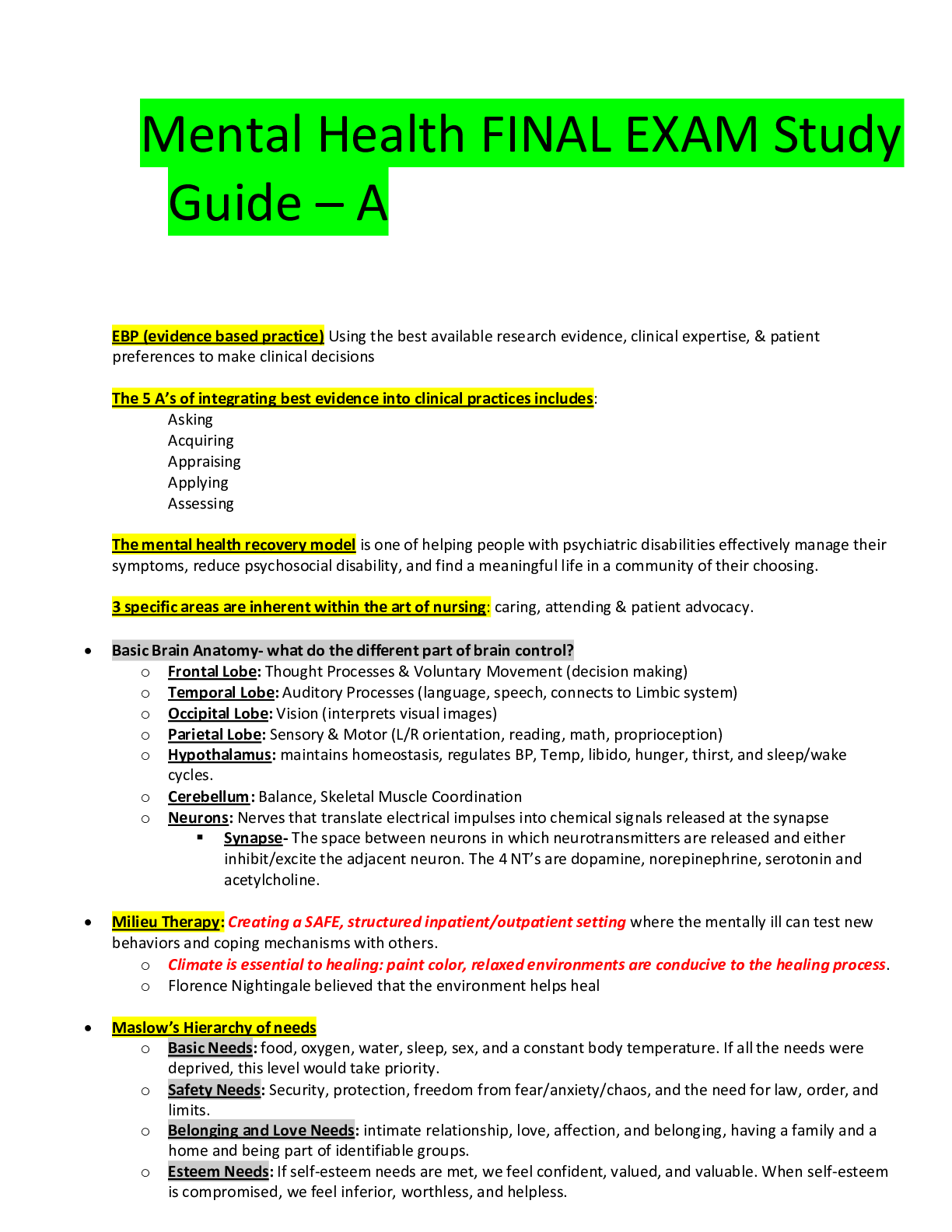Health Care > EXAM > NUR 2502 / NUR2502 Final Exam Study Guide (Latest 2021 / 2022): Multidimensional Care III / MDC 3 - (All)
NUR 2502 / NUR2502 Final Exam Study Guide (Latest 2021 / 2022): Multidimensional Care III / MDC 3 - Rasmussen College
Document Content and Description Below
NUR 2502 / NUR2502 Final Exam Study Guide (Latest 2021 / 2022): Multidimensional Care III / MDC 3 - Rasmussen College MDC 3 Final Exam Study Guide Cardiac Disorders Heart failure – 3 types • ... Left-sided heart failure – results from ineffective left ventricular contraction causing a backup of fluid into the lungs, which results in pulmonary congestion. o Symptoms ▪ Chest discomfort ▪ Dyspnea ▪ Palpitations ▪ Skipped heartbeats ▪ Tachycardia ▪ Weakness ▪ Dizziness ▪ Fatigue ▪ Oliguria (Kidney failure) • Right-sided heart failure – results from the inability of the right ventricle to effectively contract to pump blood, causing a backup of fluid into the periphery. o Symptoms ▪ Nausea ▪ Anorexia ▪ Leg edema ▪ Ascites ▪ Nocturia ▪ Hepatomegaly • High-output failure – results from an increased metabolic state in which cardiac output remains normal or above normal. High-output failure is caused by increased metabolic needs or hyperkinetic conditions, such as septicemia, high fever, anemia, and hyperthyroidism. • Patient Education o Take medication as prescribed. Avoid NSAIDS o Stay active as tolerated o Weigh daily o Limit sodium to 2-3g per day. Limit fluid to 2 L per day • Diagnostics o ABG o Chest x-ray o EKG o Echocardiogram – best tool in diagnosing HF. Mitral stenosis Is the stiffening/narrowing of the valves preventing normal blood flow from the left atrium into the left ventricle. This can lead to left atrial dilation and pulmonary congestion. • Causes o Rheumatic fever o Congenital abnormalities • Symptoms o Dyspnea o Orthopnea (SOB lying down) o Nocturnal dyspnea o Hemoptysis o Dry cough o Pulmonary HTN o Hepatomegaly Mitral Regurgitation The mitral valve does not close completely causing a backflow of blood into the Left Atrium. • Can lead to hypertrophy of the left atrium and ventricle due to increased pressure. • Causes o Rheumatic fever o Infective Endocarditis o Papillary muscle dysfunction Mitral Prolapse The enlargement of the mitral valve leaflets which then prolapse into the left atrium. • Causes o Marfan syndrome o Congenital heart disease o Genetics • What sound would you anticipate auscultating? – A midsystolic click heard at the apex of the heart. Aortic stenosis Narrowing of the aortic valve, obstructing ventricular outflow Can lead to ventricular hypertrophy resulting in effective perfusion of oxygenated blood If left untreated, can progress to right-sided heart failure. • What sound would you expect to hear if auscultating? - A diamond-shaped, systolic crescendo-decrescendo murmur Aortic regurgitation The valve does not close appropriately allowing blood to backflow into the ventricles. • Assessment Findings Top 4 Nursing Interventions: Morphine Oxygen Nitroglycerine Aspirin o Palpitations o Dyspnea o Orthopnea o Paroxysmal nocturnal dyspnea o Fatigue o Angina o Sinus tachycardia o Blowing, decrescendo diastolic murmur • Treatment o Rest o ACE inhibitors (-pril) o O2 o Beta blockers (-lol) o Digoxin o Diuretics o Calcium channel blockers (-dipine) • Multidimensional Care o Monitor patient signs and symptoms of heart failure (edema, tachypnea, tachycardia, fatigue, cough, dyspnea) o Implementation of transvenous pacing to maintain heart rate o Administer anti-coagulants as prescribed to prevent thrombus formation o Manage post-operative pain o Monitor post-operative bleeding o Daily weight o Fluid & Sodium Restriction • What sounds might you auscultate? – “bounding” apical pulse. Infective endocarditis • Causes o IV drug use o Valve replacement o Streptococcus viridans o Staphylococcus aureus • Treatment o Antibiotics o Surgery to remove/repair infected valve and shunts o Maintain proper oral hygiene – soft toothbrush twice a day • Symptoms o Fever w/ chills, night sweats, malaise, fatigue o Anorexia & weight loss o Cardiac murmur o Development of HF o Systemic embolism o Petechiae o Osler’s nodes on palms of hands and sole of feet o Janeway’s lesions – flat, reddened maculae on hands o Positive blood cultures Pericarditis This is an inflammation of the Pericardium-the sac around the heart. • Causes o Tissue damage from surgery o Trauma, o Cancer and cancer treatments o TB Rheumatic carditis Develops after an infection with Group A beta-hemolytic streptococci or Rhematic Fever. Involves layers of the heart and impacts contractility and cardiac output. Cardiomyopathy • Diagnosis o Chest x ray o Echocardiogram – evaluate valvular damage o Cardiac catheterization • Assessment Findings o Assess and monitor patient heart rate and rhythm for transplant patients o Administer immunosuppressant post-transplant to [Show More]
Last updated: 1 year ago
Preview 1 out of 19 pages
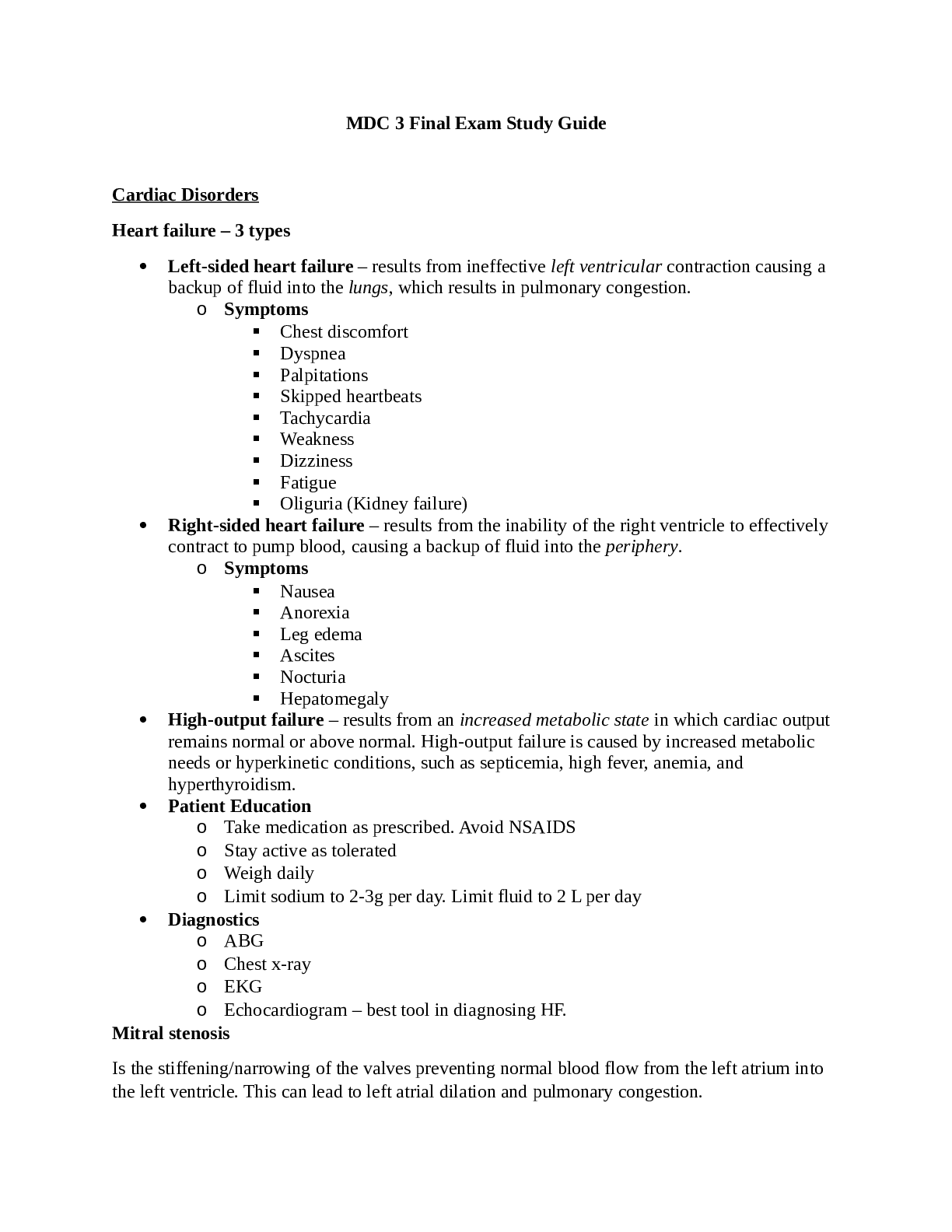
Reviews( 0 )
Document information
Connected school, study & course
About the document
Uploaded On
Jul 28, 2022
Number of pages
19
Written in
Additional information
This document has been written for:
Uploaded
Jul 28, 2022
Downloads
0
Views
36



.png)
